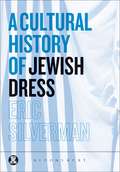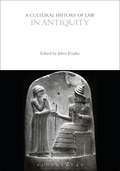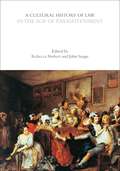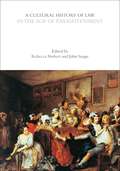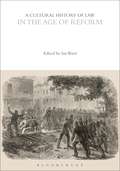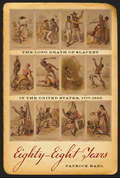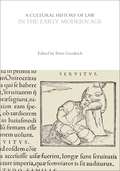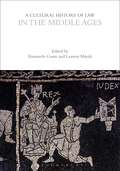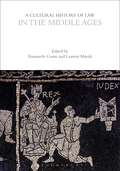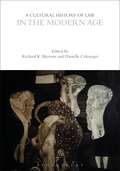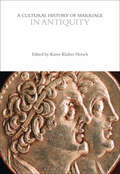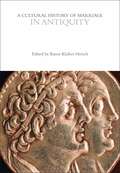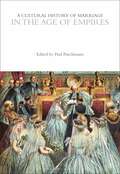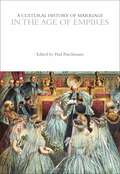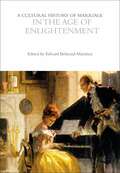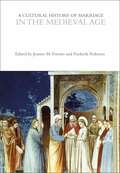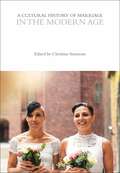- Table View
- List View
A Cultural History of Jewish Dress (Dress, Body, Culture)
by Eric SilvermanA Cultural History of Jewish Dress is the first comprehensive account of how Jews have been distinguished by their appearance from Ancient Israel to the present. For centuries Jews have dressed in distinctive ways to communicate their devotion to God, their religious identity, and the proper earthly roles of men and women. This lively work explores the rich history of Jewish dress, examining how Jews and non-Jews alike debated and legislated Jewish attire in different places, as well as outlining the big debates on dress within the Jewish community today.Focusing on tensions over gender, ethnic identity and assimilation, each chapter discusses the meaning and symbolism of a specific era or type of Jewish dress. What were biblical and rabbinic fashions? Why was clothing so important to immigrant Jews in America? Why do Hassidic Jews wear black? When did yarmulkes become bar mitzvah souvenirs? The book also offers the first analysis of how young Jewish adults today announce on caps, shirts, and even undergarments their striving to transform Jewishness from a religious and historical heritage into an ethnic identity that is hip, racy, and irreverent. Fascinating and accessibly written, A Cultural History of Jewish Dress will appeal to anybody interested in the central role of clothing in defining Jewish identity.
A Cultural History of Jewish Dress (Dress, Body, Culture)
by Eric SilvermanA Cultural History of Jewish Dress is the first comprehensive account of how Jews have been distinguished by their appearance from Ancient Israel to the present. For centuries Jews have dressed in distinctive ways to communicate their devotion to God, their religious identity, and the proper earthly roles of men and women. This lively work explores the rich history of Jewish dress, examining how Jews and non-Jews alike debated and legislated Jewish attire in different places, as well as outlining the big debates on dress within the Jewish community today.Focusing on tensions over gender, ethnic identity and assimilation, each chapter discusses the meaning and symbolism of a specific era or type of Jewish dress. What were biblical and rabbinic fashions? Why was clothing so important to immigrant Jews in America? Why do Hassidic Jews wear black? When did yarmulkes become bar mitzvah souvenirs? The book also offers the first analysis of how young Jewish adults today announce on caps, shirts, and even undergarments their striving to transform Jewishness from a religious and historical heritage into an ethnic identity that is hip, racy, and irreverent. Fascinating and accessibly written, A Cultural History of Jewish Dress will appeal to anybody interested in the central role of clothing in defining Jewish identity.
A Cultural History of Law in Antiquity (The Cultural Histories Series)
by Julen EtxabeHow should we talk about “the law” in a period so remote from our own and covering such a huge span of time and space? From the Code of Hammurabi (ca. 1750 BCE) to Justinian's Corpus Iuris Civilis (529-534 CE), A Cultural History of Law in Antiquity draws upon legal texts and non-textual forms (such as vase-painting, sculpture, and architecture) to uncover the diverse and rich legal traditions of societies ranging from the Ancient Near Eastern cities of Assyria and Babylon in Mesopotamia to the Ancient Israelites, and from Ancient Greece to Rome of the Archaic and Classical Periods.With a wealth of textual and visual sources, A Cultural History of Law in Antiquity presents essays that examine key cultural case studies of the period on the themes of justice, constitution, codes, agreements, arguments, property and possession, wrongs, and the legal profession.
A Cultural History of Law in Antiquity (The Cultural Histories Series)
by Julen EtxabeHow should we talk about “the law” in a period so remote from our own and covering such a huge span of time and space? From the Code of Hammurabi (ca. 1750 BCE) to Justinian's Corpus Iuris Civilis (529-534 CE), A Cultural History of Law in Antiquity draws upon legal texts and non-textual forms (such as vase-painting, sculpture, and architecture) to uncover the diverse and rich legal traditions of societies ranging from the Ancient Near Eastern cities of Assyria and Babylon in Mesopotamia to the Ancient Israelites, and from Ancient Greece to Rome of the Archaic and Classical Periods.With a wealth of textual and visual sources, A Cultural History of Law in Antiquity presents essays that examine key cultural case studies of the period on the themes of justice, constitution, codes, agreements, arguments, property and possession, wrongs, and the legal profession.
A Cultural History of Law in the Age of Enlightenment (The Cultural Histories Series)
by Rebecca ProbertThe period of the Enlightenment was marked by innovation in political, cultural, religious, and educational ideas with the aim of improving the experience of human beings in society. Key to intellectual debates and day-to-day life were ideas about the law. Many looked to Britain, and to the British, as exemplars of a state governed by moderate laws under a moderate constitution. Britain's laws and constitution were portrayed and satirized in almost every artistic medium. A Cultural History of Law in the Age of Enlightenment presents essays spanning the “long 18th century” (1680 to 1820) which explore the place of law in a range of creative and artistic media, all of which flourished in a commercial society with law at its center and enlightenment as its aim.Drawing upon a wealth of visual and textual sources, A Cultural History of Law in the Age of Enlightenment presents essays that examine key cultural case studies of the period on the themes of justice, constitution, codes, agreements, arguments, property and possession, wrongs, and the legal profession.
A Cultural History of Law in the Age of Enlightenment (The Cultural Histories Series)
by Rebecca Probert and John SnapeThe period of the Enlightenment was marked by innovation in political, cultural, religious, and educational ideas with the aim of improving the experience of human beings in society. Key to intellectual debates and day-to-day life were ideas about the law. Many looked to Britain, and to the British, as exemplars of a state governed by moderate laws under a moderate constitution. Britain's laws and constitution were portrayed and satirized in almost every artistic medium. A Cultural History of Law in the Age of Enlightenment presents essays spanning the “long 18th century” (1680 to 1820) which explore the place of law in a range of creative and artistic media, all of which flourished in a commercial society with law at its center and enlightenment as its aim.Drawing upon a wealth of visual and textual sources, A Cultural History of Law in the Age of Enlightenment presents essays that examine key cultural case studies of the period on the themes of justice, constitution, codes, agreements, arguments, property and possession, wrongs, and the legal profession.
A Cultural History of Law in the Age of Reform (The Cultural Histories Series)
by Ian WardThe Age of Reform – the hundred years from 1820 to 1920 - has become synonymous with innovation and change but this period was also in many ways a deeply conservative and cautious one. With reform came reaction and revolution and this was as true of the law as it was of literature, art and technology. The age of Great Exhibitions and Great Reform Acts was also the age of newly systemized police forces, courts and prisons. A Cultural History of Law in the Age of Reform presents an overview of the period with a focus on human stories located in the crush between legal formality and social reform: the newly uniformed police, criminal mugshots, judge and jury, the shame of child labor, and the need for neighborliness in the crowded urban and increasingly industrial landscapes of Europe and the United States.Drawing upon a wealth of visual and textual sources, A Cultural History of Law in the Age of Reform presents essays that examine key cultural case studies of the period on the themes of justice, constitution, codes, agreements, arguments, property and possession, wrongs, and the legal profession.
A Cultural History of Law in the Age of Reform (The Cultural Histories Series)
by Ian WardThe Age of Reform – the hundred years from 1820 to 1920 - has become synonymous with innovation and change but this period was also in many ways a deeply conservative and cautious one. With reform came reaction and revolution and this was as true of the law as it was of literature, art and technology. The age of Great Exhibitions and Great Reform Acts was also the age of newly systemized police forces, courts and prisons. A Cultural History of Law in the Age of Reform presents an overview of the period with a focus on human stories located in the crush between legal formality and social reform: the newly uniformed police, criminal mugshots, judge and jury, the shame of child labor, and the need for neighborliness in the crowded urban and increasingly industrial landscapes of Europe and the United States.Drawing upon a wealth of visual and textual sources, A Cultural History of Law in the Age of Reform presents essays that examine key cultural case studies of the period on the themes of justice, constitution, codes, agreements, arguments, property and possession, wrongs, and the legal profession.
A Cultural History of Law in the Early Modern Age (The Cultural Histories Series)
by Peter GoodrichOpened up by the revival of Classical thought but riven by the violence of the Reformation and Counter Reformation, the terrain of Early Modern law was constantly shifting. The age of expansion saw unparalleled degrees of internal and external exploration and colonization, accompanied by the advance of science and the growing power of knowledge. A Cultural History of Law in the Early Modern Age, covering the period from 1500 to 1680, explores the war of jurisdictions and the slow and contested emergence of national legal traditions in continental Europe and in Britannia. Most particularly, the chapters examine the European quality of the Western legal traditions and seek to link the political project of Anglican common law, the mos britannicus, to its classical European language and context.Drawing upon a wealth of textual and visual sources, A Cultural History of Law in the Early Modern Age presents essays that examine key cultural case studies of the period on the themes of justice, constitution, codes, agreements, arguments, property and possession, wrongs, and the legal profession.
A Cultural History of Law in the Early Modern Age (The Cultural Histories Series)
by Peter GoodrichOpened up by the revival of Classical thought but riven by the violence of the Reformation and Counter Reformation, the terrain of Early Modern law was constantly shifting. The age of expansion saw unparalleled degrees of internal and external exploration and colonization, accompanied by the advance of science and the growing power of knowledge. A Cultural History of Law in the Early Modern Age, covering the period from 1500 to 1680, explores the war of jurisdictions and the slow and contested emergence of national legal traditions in continental Europe and in Britannia. Most particularly, the chapters examine the European quality of the Western legal traditions and seek to link the political project of Anglican common law, the mos britannicus, to its classical European language and context.Drawing upon a wealth of textual and visual sources, A Cultural History of Law in the Early Modern Age presents essays that examine key cultural case studies of the period on the themes of justice, constitution, codes, agreements, arguments, property and possession, wrongs, and the legal profession.
A Cultural History of Law in the Middle Ages (The Cultural Histories Series)
by Emanuele Conte Laurent MayaliIn 500, the legal order in Europe was structured around ancient customs, social practices and feudal values. By 1500, the effects of demographic change, new methods of farming and economic expansion had transformed the social and political landscape and had wrought radical change upon legal practices and systems throughout Western Europe. A Cultural History of Law in the Middle Ages explores this change and the rich and varied encounters between Christianity and Roman legal thought which shaped the period. Evolving from a combination of religious norms, local customs, secular legislations, and Roman jurisprudence, medieval law came to define an order that promoted new forms of individual and social representation, fostered the political renewal that heralded the transition from feudalism to the Early Modern state and contributed to the diffusion of a common legal language.Drawing upon a wealth of textual and visual sources, A Cultural History of Law in the Middle Ages presents essays that examine key cultural case studies of the period on the themes of justice, constitution, codes, agreements, arguments, property and possession, wrongs, and the legal profession.
A Cultural History of Law in the Middle Ages (The Cultural Histories Series)
by Emanuele Conte and Laurent MayaliIn 500, the legal order in Europe was structured around ancient customs, social practices and feudal values. By 1500, the effects of demographic change, new methods of farming and economic expansion had transformed the social and political landscape and had wrought radical change upon legal practices and systems throughout Western Europe. A Cultural History of Law in the Middle Ages explores this change and the rich and varied encounters between Christianity and Roman legal thought which shaped the period. Evolving from a combination of religious norms, local customs, secular legislations, and Roman jurisprudence, medieval law came to define an order that promoted new forms of individual and social representation, fostered the political renewal that heralded the transition from feudalism to the Early Modern state and contributed to the diffusion of a common legal language.Drawing upon a wealth of textual and visual sources, A Cultural History of Law in the Middle Ages presents essays that examine key cultural case studies of the period on the themes of justice, constitution, codes, agreements, arguments, property and possession, wrongs, and the legal profession.
A Cultural History of Law in the Modern Age (The Cultural Histories Series)
by Richard K. Sherwin and Danielle CelermajerThe period since the First World War has been a century distinguished by the loss of any unitary foundation for truth, ethics, and the legitimate authority of law. With the emergence of radical pluralism, law has become the site of extraordinary creativity and, on occasion, a source of rights for those historically excluded from its protection. A Cultural History of Law in the Modern Age tells stories of human struggles in the face of state authority – including Aboriginal land claims, popular resistance to corporate power, and the inter-generational ramifications of genocidal state violence. The essays address how, and with what effects, different expressive modes (ceremonial dance, live street theater, the acoustics of radio, the affective range of film, to name a few) help to construct, memorialize, and disseminate political and legal meaning.Drawing upon a wealth of visual, textual and sound sources, A Cultural History of Law in the Modern Age presents essays that examine key cultural case studies of the period on the themes of justice, constitution, codes, agreements, arguments, property and possession, wrongs, and the legal profession.
A Cultural History of Law in the Modern Age (The Cultural Histories Series)
by Richard K. Sherwin Danielle CelemajerThe period since the First World War has been a century distinguished by the loss of any unitary foundation for truth, ethics, and the legitimate authority of law. With the emergence of radical pluralism, law has become the site of extraordinary creativity and, on occasion, a source of rights for those historically excluded from its protection. A Cultural History of Law in the Modern Age tells stories of human struggles in the face of state authority – including Aboriginal land claims, popular resistance to corporate power, and the inter-generational ramifications of genocidal state violence. The essays address how, and with what effects, different expressive modes (ceremonial dance, live street theater, the acoustics of radio, the affective range of film, to name a few) help to construct, memorialize, and disseminate political and legal meaning.Drawing upon a wealth of visual, textual and sound sources, A Cultural History of Law in the Modern Age presents essays that examine key cultural case studies of the period on the themes of justice, constitution, codes, agreements, arguments, property and possession, wrongs, and the legal profession.
A Cultural History of Madrid: Modernism and the Urban Spectacle
by Deborah L. ParsonsDespite its international significance, Madrid has been almost entirely ignored by urban, literary and cultural studies published in English. A Cultural History of Madrid: Modernism and the Urban Spectacle corrects that oversight by presenting an urban and cultural history of the city from the turn of the century to the early 1930s. Between 1900 and 1930, Madrids population doubled to almost one million, with less than half the population being indigenous to the city itself. Far from the Castilian capital it was made out to be, Madrid was fast becoming a socially magnetic, increasingly secular and cosmopolitan metropolis. Parsons explores the interface between elite, mass and popular culture in Madrid while considering the construction of a modern madrileo identity that developed alongside urban and social modernization. She emphasizes the interconnection of art and popular culture in the creation of a metropolitan personality and temperament. The book draws on literary, theatrical, cinematic and photographic texts, including the work of such figures as Ramn Mesonero Romanos, Benito Prez Galds, Po Baroja, Ramn Gomez de la Serna, Ramn Valle-Incln and Maruja Mallo. In addition, the author examines the development of new urban-based art forms and entertainments such as the zarzuela, music halls and cinema, and considers their interaction with more traditional cultural identities and activities. In arguing that traditional aspects of culture were incorporated into the everyday life of urban modernity, Parsons shows how the boundaries between high and low culture became increasingly blurred as a new identity influenced by modern consumerism emerged. She investigates the interaction of the geographical landscape of the city with its expression in both the popular imagination and in aesthetic representations, detailing and interrogating the new freedoms, desires and perspectives of the Madrid modernista.
A Cultural History of Marriage in Antiquity (The Cultural Histories Series)
by Karen Klaiber HerschMarriage, across cultures, is often defined as a union between consenting adults that lasts for the life of the partners. But is marriage a blessing, or curse? Does marriage represent the union of two hearts, or was it a necessary evil? Did matrimony bring a person a helpmeet for life, or was it a societally approved state entered into to improve one's social standing and produce legitimate heirs? The authors of this volume show that the peoples of the ancient Mediterranean were divided on all of these questions, and reveal ancient Greek and Roman opinions on marriage that were as varied and complex as they are today. Readers will discover in this book that ancients juggled multiple ideas that to the modern eye may appear to be contradictory. Thus, for example, Greek and Roman wives were expected to come to their grooms spotless virgins, while Greek and Roman husbands could enjoy multiple partnerships outside the marital union. Guided by our experts, we take an extensive journey through time and space, encountering evidence from such sources as diverse as Hammurabic law codes, Egyptian papyri, Greek epic and tragedy, Roman inscriptions and writings on the lives of early Christians. Applying innovative approaches and diverse methodologies, the authors of this volume reveal the tension and reconciliation between representations of marriage in antiquity and its lived reality.A Cultural History of Marriage in Antiquity presents an overview of the period with essays on Courtship and Ritual; Religion, State and Law; Kinship and Social Networks; the Family Economy; Love and Sex; the Breaking of Vows; and Representations of Marriage.
A Cultural History of Marriage in Antiquity (The Cultural Histories Series)
Marriage, across cultures, is often defined as a union between consenting adults that lasts for the life of the partners. But is marriage a blessing, or curse? Does marriage represent the union of two hearts, or was it a necessary evil? Did matrimony bring a person a helpmeet for life, or was it a societally approved state entered into to improve one's social standing and produce legitimate heirs? The authors of this volume show that the peoples of the ancient Mediterranean were divided on all of these questions, and reveal ancient Greek and Roman opinions on marriage that were as varied and complex as they are today. Readers will discover in this book that ancients juggled multiple ideas that to the modern eye may appear to be contradictory. Thus, for example, Greek and Roman wives were expected to come to their grooms spotless virgins, while Greek and Roman husbands could enjoy multiple partnerships outside the marital union. Guided by our experts, we take an extensive journey through time and space, encountering evidence from such sources as diverse as Hammurabic law codes, Egyptian papyri, Greek epic and tragedy, Roman inscriptions and writings on the lives of early Christians. Applying innovative approaches and diverse methodologies, the authors of this volume reveal the tension and reconciliation between representations of marriage in antiquity and its lived reality.A Cultural History of Marriage in Antiquity presents an overview of the period with essays on Courtship and Ritual; Religion, State and Law; Kinship and Social Networks; the Family Economy; Love and Sex; the Breaking of Vows; and Representations of Marriage.
A Cultural History of Marriage in the Age of Empires (The Cultural Histories Series)
by Paul PuschmannThis volume looks at how, during the age of empires (1800–1900), marriage was a key transition in the life course worldwide, a rite of passage everywhere with major cultural significance. While in some ways the institution of marriage became threatened – for instance through rising divorce rates in Western societies – in others it became more anchored than ever before. In Western Europe marriage was increasingly regarded as the only way to reach happiness and self-fulfillment, and romantic partner choice became a new ideal, but material interests remained nevertheless guiding principles in the selection of a partner for life. In the United States former slaves obtained the right to marry and to formalize existing bonds after the Civil War, leading to a convergence in marriage patterns between the black and white population. In Latin America, marriage was and remained less common than in other world regions – due to the prevalence of consensual unions – but marriage rates were nevertheless on the rise. A similar trend was observed in Australia and New Zealand. In African and Asian societies, European colonial powers tried to change the marriage customs of indigenous populations-for instance regarding polygamy and arranged marriages-but sooner or later they had to adapt themselves and their colonial administrations in order to avoid major resistance. In a world of turbulent political and economic change, marriage and the family remained safe havens, the linchpins of society that they had been for centuries.A Cultural History of Marriage in the Age of Empires presents an overview of the period with essays on Courtship and Ritual; Religion, State and Law; Kinship and Social Networks; the Family Economy; Love and Sex; the Breaking of Vows; and Representations of Marriage.
A Cultural History of Marriage in the Age of Empires (The Cultural Histories Series)
This volume looks at how, during the age of empires (1800–1900), marriage was a key transition in the life course worldwide, a rite of passage everywhere with major cultural significance. While in some ways the institution of marriage became threatened – for instance through rising divorce rates in Western societies – in others it became more anchored than ever before. In Western Europe marriage was increasingly regarded as the only way to reach happiness and self-fulfillment, and romantic partner choice became a new ideal, but material interests remained nevertheless guiding principles in the selection of a partner for life. In the United States former slaves obtained the right to marry and to formalize existing bonds after the Civil War, leading to a convergence in marriage patterns between the black and white population. In Latin America, marriage was and remained less common than in other world regions – due to the prevalence of consensual unions – but marriage rates were nevertheless on the rise. A similar trend was observed in Australia and New Zealand. In African and Asian societies, European colonial powers tried to change the marriage customs of indigenous populations-for instance regarding polygamy and arranged marriages-but sooner or later they had to adapt themselves and their colonial administrations in order to avoid major resistance. In a world of turbulent political and economic change, marriage and the family remained safe havens, the linchpins of society that they had been for centuries.A Cultural History of Marriage in the Age of Empires presents an overview of the period with essays on Courtship and Ritual; Religion, State and Law; Kinship and Social Networks; the Family Economy; Love and Sex; the Breaking of Vows; and Representations of Marriage.
A Cultural History of Marriage in the Age of Enlightenment (The Cultural Histories Series)
by Edward Behrend-MartínezCould an institution as sacred and traditional as marriage undergo a revolution? Some people living during the so-called Age of Enlightenment thought so. By marrying for that selfish, personal emotion of love rather than to serve religious or family interests, to serve political demands or the demands of the pocketbook, a few but growing number of people revolutionized matrimony around the end of the eighteenth century. Marriage went from being a sacred state, instituted by the Church and involving everyone to – for a few intrepid people – a secular contract, a deal struck between two individuals based entirely on their mutual love and affection.Few would claim today that love is not the cornerstone of modern marriage. The easiest argument in favor of any marriage today, no matter how star-crossed the individuals, is that the couple is deeply and hopelessly in love with one another. But that was not always so clear. Before the eighteenth century very few couples united simply because they shared a mutual attraction and affection for one another. Yet only a century later most people would come to believe that mutual love and even attraction were necessary for any marriage to succeed. A Cultural History of Marriage in the Age of Enlightenment explores the ways that new ideas, cultural ideals, and economic changes, big and small, reshaped matrimony into the institution that it is today, allowing love to become the ultimate essential ingredient for modern marriages.A Cultural History of Marriage in the Age of Enlightenment presents an overview of the period with essays on Courtship and Ritual; Religion, State and Law; Kinship and Social Networks; the Family Economy; Love and Sex; the Breaking of Vows; and Representations of Marriage.
A Cultural History of Marriage in the Age of Enlightenment (The Cultural Histories Series)
Could an institution as sacred and traditional as marriage undergo a revolution? Some people living during the so-called Age of Enlightenment thought so. By marrying for that selfish, personal emotion of love rather than to serve religious or family interests, to serve political demands or the demands of the pocketbook, a few but growing number of people revolutionized matrimony around the end of the eighteenth century. Marriage went from being a sacred state, instituted by the Church and involving everyone to – for a few intrepid people – a secular contract, a deal struck between two individuals based entirely on their mutual love and affection.Few would claim today that love is not the cornerstone of modern marriage. The easiest argument in favor of any marriage today, no matter how star-crossed the individuals, is that the couple is deeply and hopelessly in love with one another. But that was not always so clear. Before the eighteenth century very few couples united simply because they shared a mutual attraction and affection for one another. Yet only a century later most people would come to believe that mutual love and even attraction were necessary for any marriage to succeed. A Cultural History of Marriage in the Age of Enlightenment explores the ways that new ideas, cultural ideals, and economic changes, big and small, reshaped matrimony into the institution that it is today, allowing love to become the ultimate essential ingredient for modern marriages.A Cultural History of Marriage in the Age of Enlightenment presents an overview of the period with essays on Courtship and Ritual; Religion, State and Law; Kinship and Social Networks; the Family Economy; Love and Sex; the Breaking of Vows; and Representations of Marriage.
A Cultural History of Marriage in the Medieval Age (The Cultural Histories Series)
by Joanne M. Ferraro and Frederik PedersenMarriage in Europe became a central pillar of society during the medieval period. Theologians, lawyers, and secular and church leaders agreed on a unique outline of the institution and its legal framework, the essential features of which remained in force until the 1980s. The medieval Western European definition of marriage was unique: before the legal consequences of marriage came into being, the parties had to promise to engage in sexual union only with one partner and to remain in the marriage until one of the parties died. This requirement had profound implications for inheritance rules and for the organization of the family economy; it was explained and justified in a multitude of theological discussions and legal decisions across all faiths on the European continent. Normative texts, built on the foundations of the scriptures of several religious traditions, provided an impressive intellectual framework around marriage. In addition, developments in iconography, including sculpture and painting, projected the dominant model of marriage, while social, demographic and cultural changes encouraged its adoption.This volume traces the medieval discussion of marriage in practice, law, theology and iconography. It provides an examination of the wider political and economic context of marriage and offers an overview of the ebb and flow of society's ideas about how expressions of human sexuality fit within the confines of a clearly defined social structure and ideology.A Cultural History of Marriage in the Medieval Age presents an overview of the period with essays on Courtship and Ritual; Religion, State and Law; Kinship and Social Networks; the Family Economy; Love and Sex; the Breaking of Vows; and Representations of Marriage.
A Cultural History of Marriage in the Medieval Age (The Cultural Histories Series)
Marriage in Europe became a central pillar of society during the medieval period. Theologians, lawyers, and secular and church leaders agreed on a unique outline of the institution and its legal framework, the essential features of which remained in force until the 1980s. The medieval Western European definition of marriage was unique: before the legal consequences of marriage came into being, the parties had to promise to engage in sexual union only with one partner and to remain in the marriage until one of the parties died. This requirement had profound implications for inheritance rules and for the organization of the family economy; it was explained and justified in a multitude of theological discussions and legal decisions across all faiths on the European continent. Normative texts, built on the foundations of the scriptures of several religious traditions, provided an impressive intellectual framework around marriage. In addition, developments in iconography, including sculpture and painting, projected the dominant model of marriage, while social, demographic and cultural changes encouraged its adoption.This volume traces the medieval discussion of marriage in practice, law, theology and iconography. It provides an examination of the wider political and economic context of marriage and offers an overview of the ebb and flow of society's ideas about how expressions of human sexuality fit within the confines of a clearly defined social structure and ideology.A Cultural History of Marriage in the Medieval Age presents an overview of the period with essays on Courtship and Ritual; Religion, State and Law; Kinship and Social Networks; the Family Economy; Love and Sex; the Breaking of Vows; and Representations of Marriage.
A Cultural History of Marriage in the Modern Age (The Cultural Histories Series)
by Christina SimmonsSpanning cultures across the 20th century, this volume explores how marriage, especially in the West, was disestablished as the primary institution organizing social life. In the developing world, the economic, social, and legal foundations of traditional marriage are stronger but also weakening. Marriage changed because an industrial wage economy reduced familial patriarchal control of youth and women and spurred demands and possibilities for greater autonomy and choice in love. After the Second World War, when more married women pursued education and employment, and gays and lesbians gained visibility, feminism and gay liberation also challenged patriarchal and restrictive gender roles and helped to reshape marriage. In 1920 most people married for life; in the twenty-first century fewer marry, and serial monogamy prevails. Marriage is more diverse and flexible in form but also more fragile and optional than it once was.Over the century control of courtship shifted from parents to youth, and friends, as opposed to kin, became more important in sustaining marriages. Dual-wage-earner families replaced the male breadwinner. Social and political liberalism assailed conservative laws and religious regimes, expanding access to divorce and birth control. Although norms of masculinity and femininity retain huge power in most cultures, visions of more egalitarian and romantic love as the basis of marriage have gained traction-made appealing by the global spread of capitalist social relations and also broadcast by culture industries in the developed world. The legalization of same-sex marriage-in over twenty-five nations by 2020-epitomizes a century of change toward a less gender-defined ideal that includes a continued desire for social recognition and permanence.A Cultural History of Marriage in the Modern Age presents an overview of the period with essays on Courtship and Ritual; Religion, State and Law; Kinship and Social Networks; the Family Economy; Love and Sex; the Breaking of Vows; and Representations of Marriage.
A Cultural History of Marriage in the Modern Age (The Cultural Histories Series)
Spanning cultures across the 20th century, this volume explores how marriage, especially in the West, was disestablished as the primary institution organizing social life. In the developing world, the economic, social, and legal foundations of traditional marriage are stronger but also weakening. Marriage changed because an industrial wage economy reduced familial patriarchal control of youth and women and spurred demands and possibilities for greater autonomy and choice in love. After the Second World War, when more married women pursued education and employment, and gays and lesbians gained visibility, feminism and gay liberation also challenged patriarchal and restrictive gender roles and helped to reshape marriage. In 1920 most people married for life; in the twenty-first century fewer marry, and serial monogamy prevails. Marriage is more diverse and flexible in form but also more fragile and optional than it once was.Over the century control of courtship shifted from parents to youth, and friends, as opposed to kin, became more important in sustaining marriages. Dual-wage-earner families replaced the male breadwinner. Social and political liberalism assailed conservative laws and religious regimes, expanding access to divorce and birth control. Although norms of masculinity and femininity retain huge power in most cultures, visions of more egalitarian and romantic love as the basis of marriage have gained traction-made appealing by the global spread of capitalist social relations and also broadcast by culture industries in the developed world. The legalization of same-sex marriage-in over twenty-five nations by 2020-epitomizes a century of change toward a less gender-defined ideal that includes a continued desire for social recognition and permanence.A Cultural History of Marriage in the Modern Age presents an overview of the period with essays on Courtship and Ritual; Religion, State and Law; Kinship and Social Networks; the Family Economy; Love and Sex; the Breaking of Vows; and Representations of Marriage.
